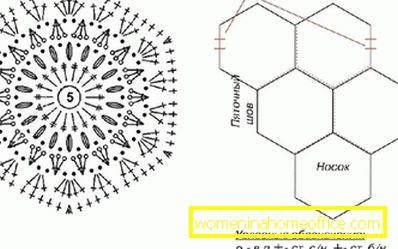Slippers boots crochet hexagon
Not so long ago, unusual knitted things came into vogue, including not only tunics, dresses and tops, but also shoes: summer ballet flats, boots, sandals, the upper part of which is crocheted, look elegant and interesting.
But this is not very practical. But for home use slippers, boots or socks are perfect. We suggest you to replenish your wardrobe with this stylish element.
Master class on knitting slippers, boots, hexagon crochet
The main attractiveness of this method lies in the fact that, based on the scheme presented to it, it is possible to make both short slippers with a low boot and full-fledged boots. In addition, you can use the pattern itself for any other items and products - from decorative napkins to shawls or tunics. All calculations are given for a foot length of 24-25 cm and can be changed at your discretion.

- It is recommended to pick yarn from microfiber, however, if you want very warm winter slippers, you can purchase wool, and then make an additional felt sole so that the product turns directly into shoes, and is not socks. The approximate volume of microfiber is 100 g or 225 m. Experts advise to crochet No. 3, but you can also take smaller models that will make the pattern denser.
- The whole essence of the work lies in knitting hexagons according to the scheme: after you cope with the first element, the rest will no longer be difficult for you. On low slippers you need 6 such parts, which will be interconnected, and if you need a high bootleg, add another 2-3 elements.

- The work begins with the fact that 6 air loops are crocheted, after which they must be looped: this is the center, the starting point. From it, 3 lifting loops are performed, after which the columns are executed with 2 nakida - there will be 17 of them and they should also be looped. As a result, you will have 3 columns from each initial loop, and the current number of loops in a row is 18.
- The next is a row of lush columns, which are created as follows: after 2 air loops on a hoist, a hook is inserted into the initial loop of the finished row and the thread is pulled, and then the action is repeated. After that, you will have 5 loops in your work, which you need to knit together, forming an air column extended to the center. According to this scheme, make another 17 pcs., Until the completion of the circle.
- There remained exactly half the work, if we take it in rows. Next are the double crochets, which are brought together at the top. Moreover, from each loop you get 3 columns, but in 1 loop. To do this, make 2 air loops on the rise, put the thread on the hook and pull it into the air loop of the lower row. Pull out the hook, knit 2 loops, make a nakid again before the pair left on the hook, and then pull it back into the lower loop between the puffy columns, and pull it again to knit the remaining 2 loops. After that you will have 3 columns, which are connected in 1 loop. By analogy, work another 17 loops.
- The last rows begin to form a geometrical clear figure, the corners are added. Each of them is obtained through a large number of double crochets - in the corners it is 5 pieces, while the rest of the circle takes only 3 pieces. Thus, in the corners of 3 air lift loops turn into 5 double crochets, then 2 times 3 columns, and then again 5. And this algorithm is repeated until the circle closes.
- Now it remains only to tie this part to a close next, for which it is recommended to use simple columns without single crochets. Keep in mind that they are given for each loop, so the last row consists of 60 such columns, plus 6 corner ones that can be paired, for greater graphism.

As already mentioned, similar elements on slippers will require at least 6 pieces, after which they are joined together with their sides, sewn together with the same thread, which, again, is better to do with a crochet hook. When the upper part is formed, it remains only to hem it to the insole: you can use the sled print cut out of felt, or you can crochet 2 parts of the same shape and size. Their scheme is solid columns with 1 or 2 nakida, so you should not have any particular difficulties.
In conclusion, it is worth noting that in itself the scheme of slippers, socks or slippers, boots is quite simple and amenable to even novice needlewomen. It is easiest to work through the creation of several identical parts and their subsequent combination, but if you still can not get patterns, start by knitting classic boots with a crochet hook from the posts.